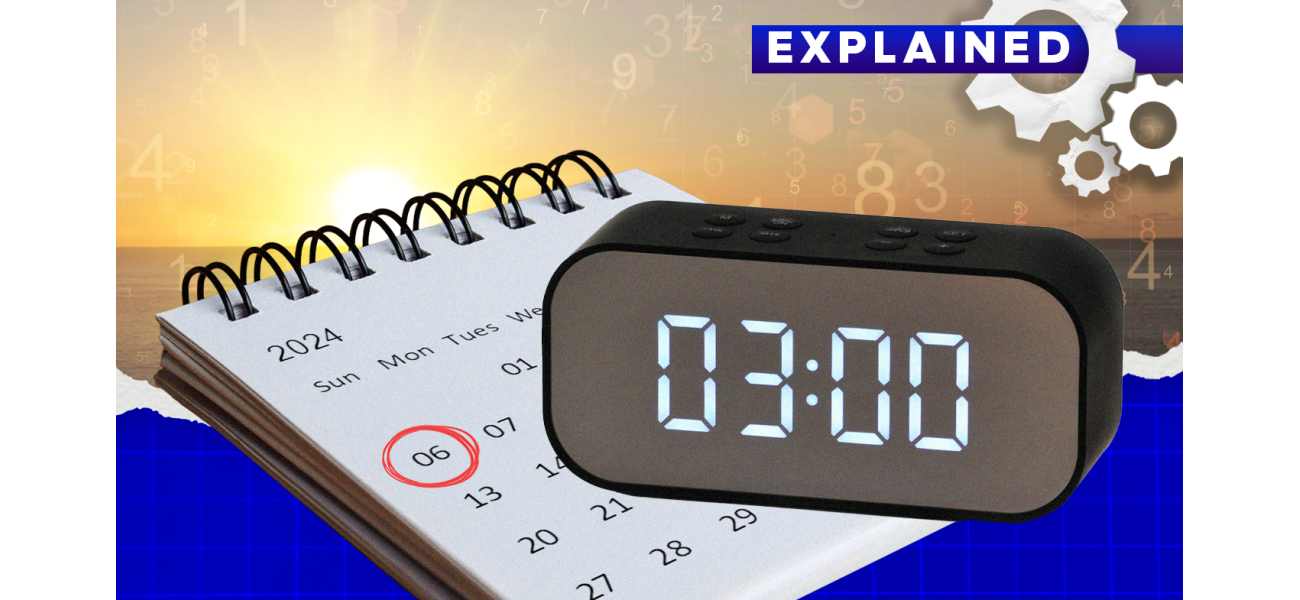When does daylight saving begin and which way do clocks change?
The upcoming season change brings warmer temperatures and longer days leading up to summer.
September 24th 2024.

As the temperatures start to rise and summer approaches, many people may have noticed that the days are getting longer. This is because daylight saving time is about to begin again in early October, with some states even declaring the day a long weekend.
For those who may not be familiar with the concept, daylight saving is a time change where the clocks are moved forward by an hour, resulting in later sunsets. This allows for more sunlight in the evenings, making it feel like we have more time to enjoy the warmer weather. In Australia, New South Wales, the Australian Capital Territory, Victoria, South Australia, and Tasmania will all observe daylight saving, while Queensland, Western Australia, and the Northern Territory will not.
If you're wondering when exactly daylight saving will begin, mark your calendars for Sunday, October 6 at 2am AEST. During this time, the clocks will move forward by an hour, meaning that the hour hand will turn from 2am to 3am AEDT. So, to answer the age-old question, yes, we do gain or lose an hour of sleep. In this case, we will lose an hour of sleep, so it's best to prepare for that and set your alarms accordingly.
However, the trade-off for losing an hour of sleep is that we get to enjoy an extra hour of sunlight in the evenings. This is perfect for those who love spending time outside and soaking up the warm weather. From October onwards, there will be a time difference between states and territories, with NSW, ACT, Victoria, and Tasmania all being in the Australian Eastern Daylight Time zone. Queensland will remain on Australian Eastern Standard Time, South Australia will follow Australian Central Daylight Time, Western Australia will stay on Australian Western Standard Time, and the NT will remain on Australian Central Standard Time.
For example, if it's 12pm in NSW, ACT, Victoria, and Tasmania, it will be 11am in Queensland, 11:30am in South Australia, 9am in Western Australia, and 10:30am in the NT. This time difference may take some getting used to, but it's important to keep in mind when planning events or meetings with friends and family across different states and territories.
If you're wondering when daylight saving will end, mark your calendars for Sunday, April 6, 2025 at 3am AEDT. During this time, the clocks will be turned back to 2am AEST, officially ending daylight saving. But why do we have daylight saving in the first place?
The concept was first introduced in Australia during World War I and II as a way to reduce energy usage. This idea came from Britain, which had already implemented their own daylight saving. In 1967, Tasmania became the first state to permanently introduce daylight saving as a response to a drought. Eventually, NSW, ACT, Victoria, and South Australia also decided to permanently observe daylight saving, while Queensland, Western Australia, and the NT opted out.
There are also a few different individuals who have been credited for creating the modern idea of daylight saving. Benjamin Franklin is often mentioned as the first to introduce the concept in his essay titled An Economical Project in 1784. However, his suggestion was simply for Parisians to wake up an hour earlier to save on candle usage.
Others who have been credited with creating daylight saving include New Zealand entomologist George Vernon Hudson and British builder William Willett. Hudson proposed a two-hour shift forward in October and a shift back in March in 1895, but it never came to fruition. Ten years later, Willett suggested a more gradual approach, setting the clocks ahead by 20 minutes each Sunday in April and switching them back in September. It wasn't until wartime in 1916 that Germany and then the UK officially adopted daylight saving to conserve energy.
So, while adjusting to the time difference and losing an hour of sleep may be a bit of an inconvenience, it's important to remember the purpose behind daylight saving and how it can benefit us in the long run. Plus, it's always fun to have an extra hour of sunlight to enjoy the warmer weather and all the outdoor activities that come with it.
For those who may not be familiar with the concept, daylight saving is a time change where the clocks are moved forward by an hour, resulting in later sunsets. This allows for more sunlight in the evenings, making it feel like we have more time to enjoy the warmer weather. In Australia, New South Wales, the Australian Capital Territory, Victoria, South Australia, and Tasmania will all observe daylight saving, while Queensland, Western Australia, and the Northern Territory will not.
If you're wondering when exactly daylight saving will begin, mark your calendars for Sunday, October 6 at 2am AEST. During this time, the clocks will move forward by an hour, meaning that the hour hand will turn from 2am to 3am AEDT. So, to answer the age-old question, yes, we do gain or lose an hour of sleep. In this case, we will lose an hour of sleep, so it's best to prepare for that and set your alarms accordingly.
However, the trade-off for losing an hour of sleep is that we get to enjoy an extra hour of sunlight in the evenings. This is perfect for those who love spending time outside and soaking up the warm weather. From October onwards, there will be a time difference between states and territories, with NSW, ACT, Victoria, and Tasmania all being in the Australian Eastern Daylight Time zone. Queensland will remain on Australian Eastern Standard Time, South Australia will follow Australian Central Daylight Time, Western Australia will stay on Australian Western Standard Time, and the NT will remain on Australian Central Standard Time.
For example, if it's 12pm in NSW, ACT, Victoria, and Tasmania, it will be 11am in Queensland, 11:30am in South Australia, 9am in Western Australia, and 10:30am in the NT. This time difference may take some getting used to, but it's important to keep in mind when planning events or meetings with friends and family across different states and territories.
If you're wondering when daylight saving will end, mark your calendars for Sunday, April 6, 2025 at 3am AEDT. During this time, the clocks will be turned back to 2am AEST, officially ending daylight saving. But why do we have daylight saving in the first place?
The concept was first introduced in Australia during World War I and II as a way to reduce energy usage. This idea came from Britain, which had already implemented their own daylight saving. In 1967, Tasmania became the first state to permanently introduce daylight saving as a response to a drought. Eventually, NSW, ACT, Victoria, and South Australia also decided to permanently observe daylight saving, while Queensland, Western Australia, and the NT opted out.
There are also a few different individuals who have been credited for creating the modern idea of daylight saving. Benjamin Franklin is often mentioned as the first to introduce the concept in his essay titled An Economical Project in 1784. However, his suggestion was simply for Parisians to wake up an hour earlier to save on candle usage.
Others who have been credited with creating daylight saving include New Zealand entomologist George Vernon Hudson and British builder William Willett. Hudson proposed a two-hour shift forward in October and a shift back in March in 1895, but it never came to fruition. Ten years later, Willett suggested a more gradual approach, setting the clocks ahead by 20 minutes each Sunday in April and switching them back in September. It wasn't until wartime in 1916 that Germany and then the UK officially adopted daylight saving to conserve energy.
So, while adjusting to the time difference and losing an hour of sleep may be a bit of an inconvenience, it's important to remember the purpose behind daylight saving and how it can benefit us in the long run. Plus, it's always fun to have an extra hour of sunlight to enjoy the warmer weather and all the outdoor activities that come with it.
[This article has been trending online recently and has been generated with AI. Your feed is customized.]
[Generative AI is experimental.]
0
0
Submit Comment





